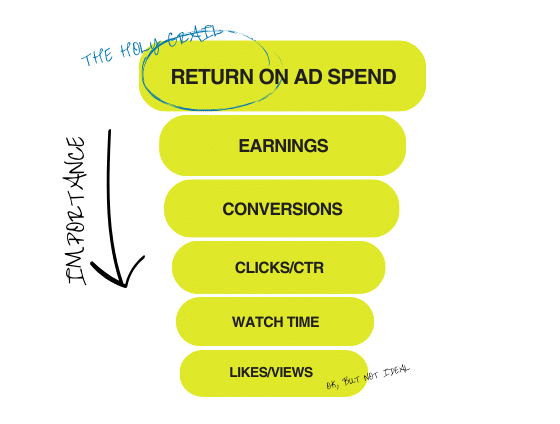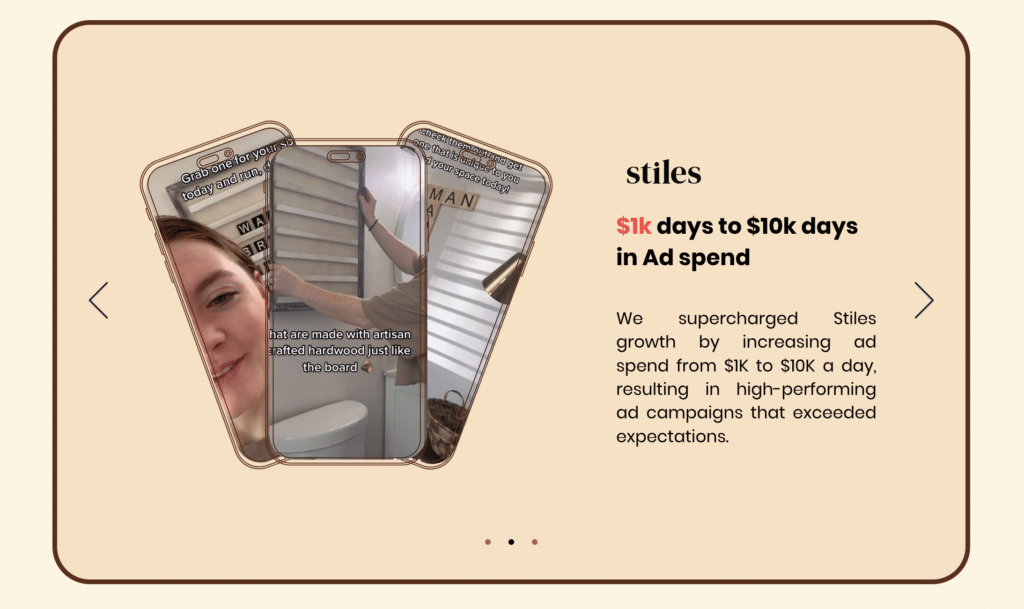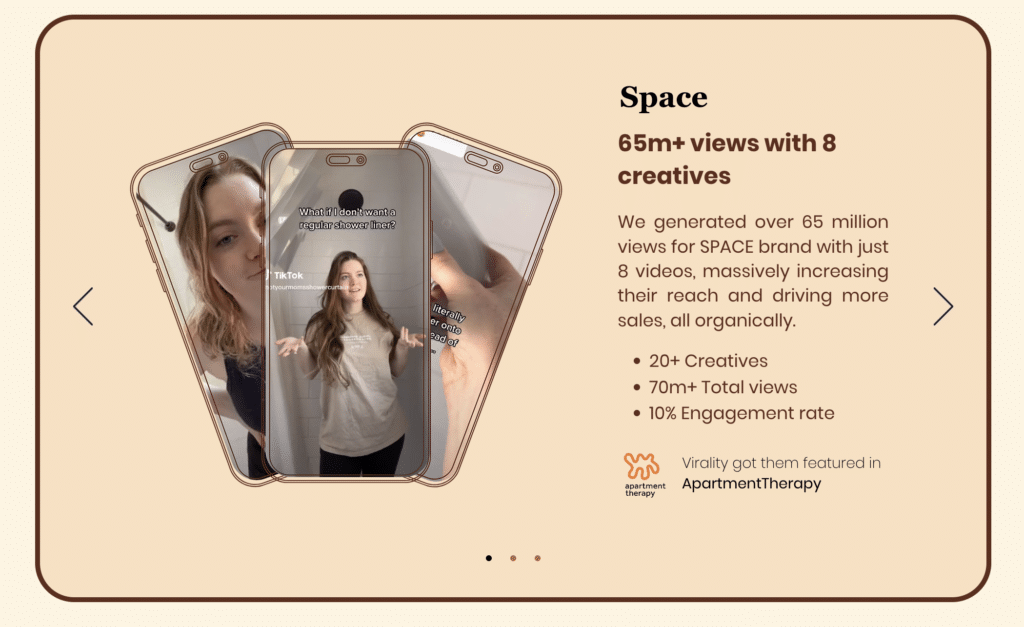If you want to increase your success rate when pitching to UGC clients, you need to get case studies. There are no two ways about it: if you want clients to trust you enough to pay your rates, you need to give them a reason.
With UGC creators popping up in their thousands, the only way to do that is by giving COLD. HARD. FACTS. Receipts, proof, timeline…. You know the drill.

Including case studies in your UGC portfolio is a sure fire way to set yourself apart from other UGC creators. Today, we’re running through how to do that.
What are UGC case studies?
In their simplest form, case studies are a detailed breakdown of how something went. In the context of UGC, a case study details the performance of your work for a brand.
As a creator, you want case studies that:
- Indicate successful work you’ve done in the past
- Imply that you can create more successful work in the future
- Highlights the sheer delight from brands you’ve worked with
Without case studies, you have no proof that you can do what you say you can, and that you are worth your rates. Without proof you are just a commodity. Being a commodity means ‘material that can be bought or sold’. Without case studies, brands will look for the cheapest commodity they can find.
And we all know there are a good few cheap UGC creators out there.
You want to set yourself apart.
What should be included in a case study?
One word. Results. The closer to the $$$ that those results are the better. In order from most valuable to least valuable:

When considering what to add to your UGC case studies (or what to ask for), you want to get as close to the money as possible. Your case study should answer one question: did the brand profit? And if so, by how much. Putting a number on that makes it so much easier for potential clients to justify paying your rates.
Consider including the following:
Return on Ad Spend/Return on Investment
ROAS (Return on Ad Spend) is the closest that a business can get to physically printing money. If I create an ad for Nike (for free, just to make the math simple) and for every $300 in ad spend, they earn an average $1,500 in new sales, they are getting a 5:1 return on their ad spend.
With a figure like a ROAS of 5 on your portfolio, potential clients can do the maths in their own head with your rates.
Earnings
Earnings are a great number to use alongside return on ad spend/return on investment. Sometimes the ROAS may be low, but the total earnings are still high which can be appealing to brands. For example, if you created an ad with a 1.8 return on ad spend, this doesn’t sound so good. BUT, let’s say the brand spent $100,000 boosting the post: suddenly, you’ve got an ad that returned $180,000 in an X month period. That’s now more powerful.

Great example of case studies from Creatively Madi
Conversions
Conversions are great too, especially in th app space. Maybe you did a video for an app and the goal of the campaign was to get people to download a free game. If you can show a video for an app and attribute 900 conversions to it, the next time someone working on marketing for an app is going to be more confident in your ability to get them results. EVEN, if your rate is higher than other creators.
Clicks/Click-through rate
Clicks are great, because the goal of most ads is preliminarily just to get clicks. If Nike want to sell shoes from my ad, the first step is to get people to click through from it. A good cost-per-click is as close to $0.00 as possible. Depending on the industry, anything in the $0.10-$0.30 range is outstanding. Click through rate (CTR) is simply a percentage of clicks per views. If you get 100 views on an ad and 3 people click through, that would be a 3% click through rate. It varies by the industry, but anything above 3% is generally strong.
Watch time/retention
You don’t have to worry about clicks if people don’t even watch your ads. Retention rate is everything for both paid and organic posts, and determines virality/CPM respectively.
Comments/likes/views
Comments, likes and views are the main metric people use to look at how organic posts are performing. Any project where you did well with these for a brand (or a video that featured any product at all) is worth creating a case study out of. There is no specific amount that makes it worth a case study. Your case study could be about how you took a brand from average of 200 views per video to 4,000 views, or a post for a moisturizer that got 300 comments.

Testimonials
Testimonials from brands are amazing but they don’t really guarantee much for the brand that is considering working with you. Every portfolio should have testimonials: these help put the decision maker’s mind at ease. Think about when you read reviews on amazon, often, you already know you want the product — you read reviews to confirm you are making the right choice.
There is not a one size fits all for case studies, every UGC creator has different strengths and weaknesses, so adjust accordingly. Anything you can do to a concrete proof to your portfolio will help position you above newer and less experienced creators.
How to get case studies from brands
Ok, so what if you’re reading this and thinking: “I’m a new creator with no social proof” — we’ve all been there. First, you’re going to set yourself the challenge of spending two weeks pitching case study content.
Start by pitching brands on running paid ads with content you’ll provide FOR FREE. Organic content can rarely be attributed to anything close to the $$$. Paid ads however have a measurable return on investment. A decent paid ad that doubled the brand’s investment could happen fairly quickly, and you would have a case study. Drop the stigma around ‘gifted’ work — this benefits you too.
How to get the analytics?
If you’re looking to get analytics for a video you’ve already filmed, there are several ways to get the numbers from a brand, and none are a guarantee. And there’s a good reason for that. IT’S A PAIN IN THE ASS. If you’re a brand, having to go find the analytics is not a good use of your time. It just isn’t. So you need to make it as easy as possible for them, and give them an inkling that what you want them to do will benefit them.
Try something like this.
Hey [name]. I wanted to reach out and offer you a bonus video — working with [brand name] was a great experience, and I want to make sure you get a really strong return on your investment in me so we can start talking about bigger prackages. Can you just send me the analytics of the ad we did really quickly so I can make sure this one performs even better? All I need is the clickthrough rate, ad spend and total earnings from the ad. With those numbers I’ll know exactly what to improve upon for this bonus video.
And if you don’t want to do a free video?
Realistically, one free video for the analytics that would allow you to form a case study that acts as the basis for drastically increasing your rates is not a bad deal. But if you don’t want to, then find another benefit to frame up as the reason you need the analytics from them.
- Maybe you are doing a three post deal and two posts are already live? In a case like that, tell them that you need the analytics from the last two posts to make sure this one outperforms both of them combined.
- Maybe you offer to create two new hooks and send them over for testing in exchange for the analytics.
- A specific discount on their next package with you in exchange for the analytics.
No matter what benefit you choose, be very clear that it’s a benefit to them and be clear about what analytics you want.










